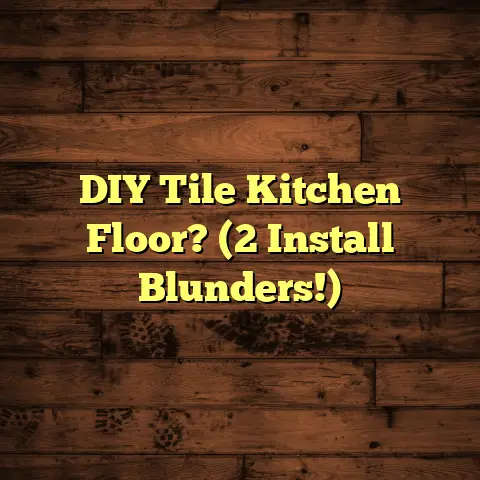Clean A Floor Drain Trap (10 Blockage Fixes!)
Ever walked into your basement or laundry room and been hit with that unmistakable stench?
Or worse, found a puddle where there shouldn’t be one?
Yeah, I’ve been there. It’s almost always a clogged floor drain, isn’t it?
That feeling of “Oh no, not this again!” is something I know all too well.
It’s frustrating, a little gross, and suddenly you’re worried about water damage, mold, and who knows what else lurking down there.
It throws a wrench in your day, doesn’t it?
But here’s the thing: a clean, free-flowing floor drain is a game-changer.
It’s not just about getting rid of the smell or the water.
It’s about peace of mind.
It’s about knowing your home is healthy, functioning properly, and not slowly turning into a swamp.
I remember one time, a client called me in a panic.
Their basement floor drain had backed up, and they were convinced their entire house was going to flood.
After a quick assessment, I found a hairball the size of a small rodent (seriously!).
Once that was cleared, the relief on their faces was priceless.
They went from stressed and overwhelmed to practically giddy with joy.
It sounds silly, but a clean drain really can make that much of a difference.
In this article, I’m going to walk you through everything you need to know to tackle those pesky floor drain blockages.
We’ll cover the basics, the tools you’ll need, and ten different methods for getting your drain flowing freely again.
I’ll even share some tips on how to prevent clogs in the first place.
Think of this as your ultimate guide to floor drain freedom.
Let’s get started, shall we?
Section 1: Understanding Floor Drains and Their Importance
Okay, so what exactly is a floor drain?
And why should you care about it?
Essentially, a floor drain is a plumbing fixture designed to remove excess water from floors.
You’ll typically find them in areas prone to moisture, like:
- Basements
- Laundry rooms
- Garages
- Bathrooms (especially in older homes)
- Commercial kitchens
Think of them as your home’s last line of defense against flooding and water damage.
Floor drains are connected to your home’s plumbing system, channeling water away from your living space and into the sewer line or septic tank.
They’re usually positioned at the lowest point of a room so gravity can do its job.
Why are they so important?
Well, without floor drains, even minor leaks or spills could lead to serious problems.
Imagine a washing machine overflowing in your laundry room with no drain in sight.
You’d be mopping for days!
Floor drains prevent water from pooling, which can lead to:
- Water damage: Ruined flooring, drywall, and belongings.
- Mold growth: A major health hazard, especially for those with allergies or respiratory issues.
- Pest infestations: Standing water attracts insects and rodents.
- Unpleasant odors: Stagnant water breeds bacteria, leading to foul smells.
Common Blockages:
So, what exactly clogs these vital drains? Here are some of the usual suspects:
- Debris accumulation: Dirt, leaves, hair, and other small particles that wash down the drain.
- Grease buildup: Especially common in kitchen floor drains, grease solidifies and sticks to the drain walls.
- Foreign objects: Toys, rags, or anything else that accidentally falls into the drain.
- Mineral deposits: Hard water can leave behind mineral deposits that restrict water flow.
Health Risks:
A clogged floor drain isn’t just a nuisance; it can also pose health risks.
Standing water creates a breeding ground for bacteria, mold, and mildew.
These can trigger allergic reactions, respiratory problems, and other health issues.
According to the EPA, mold growth can occur within 24-48 hours of water damage, which is why addressing clogs quickly is crucial.
Pest infestations are another concern.
Cockroaches, mosquitoes, and rodents are attracted to standing water and can spread diseases.
Keeping your floor drains clean is essential for maintaining a healthy and safe home environment.
Section 2: Tools and Materials Needed for Cleaning
Alright, let’s talk tools!
Before you dive headfirst into unclogging that drain, you’ll want to gather the right equipment.
Trust me, having the right tools makes the job way easier and more effective.
Here’s a comprehensive list of what you’ll need:
- A bucket or basin: To catch any water or debris you pull out of the drain.
- Gloves and safety goggles: Protect your hands and eyes from bacteria and chemicals.
- A plunger: A classic tool for dislodging minor blockages.
- A plumber’s snake (also called a drain auger): For reaching deeper clogs that a plunger can’t handle.
- A wet/dry vacuum: To suck out standing water and loose debris.
- Drain cleaner (chemical and natural options): For dissolving stubborn clogs.
- A flashlight: To get a good look down the drain.
- Screwdriver: For removing the drain cover.
- Old toothbrush or scrub brush: For cleaning the drain cover and surrounding area.
Let’s break down each tool and its purpose:
- Bucket/Basin: This is your catch-all for the yuck you’re about to pull out of the drain.
Trust me, you’ll want one. - Gloves & Goggles: Safety first!
You’re dealing with potentially nasty stuff, so protect yourself.
I always recommend heavy-duty rubber gloves and safety goggles. - Plunger: The plunger creates suction that can dislodge minor clogs.
It’s best for clogs close to the drain opening. - Plumber’s Snake: This flexible tool can reach deep into the drainpipe to break up or pull out stubborn clogs.
It’s a must-have for serious blockages. - Wet/Dry Vacuum: This is your cleanup superhero.
It can suck up standing water and loose debris, making the cleaning process much easier. - Drain Cleaner (Chemical & Natural): Chemical drain cleaners can dissolve tough clogs, but they should be used with caution.
Natural alternatives like baking soda and vinegar are gentler but may not be as effective for severe blockages. - Flashlight: Shine some light down the drain to get a better view of the blockage.
- Screwdriver: Most floor drain covers are held in place by screws.
You’ll need a screwdriver to remove the cover. - Old Toothbrush/Scrub Brush: Use this to scrub the drain cover and surrounding area, removing any grime or buildup.
Having these tools on hand will make the cleaning process much smoother and more efficient.
Section 3: Preparing for the Cleaning Process
Before you start plunging, snaking, or pouring anything down that drain, it’s important to take a few preparatory steps.
This will ensure your safety and make the cleaning process more effective.
Safety First:
- Wear gloves and safety goggles: This is non-negotiable.
You’re dealing with potentially harmful bacteria and chemicals, so protect your skin and eyes. - Ensure proper ventilation: Open windows or turn on a fan to ventilate the area.
This is especially important when using chemical drain cleaners, which can release fumes. - Keep children and pets away: Keep kids and pets away from the area to prevent accidents.
Preparing the Area:
- Remove any obstacles: Clear away any furniture, rugs, or other items that might be in the way.
- Protect the surrounding floor: Lay down a drop cloth or old towels to protect the floor from spills and splashes.
- Locate the drain cover: Find the drain cover and identify how it’s attached.
Most covers are held in place by screws, but some simply lift off. - Remove the drain cover: Use a screwdriver to remove any screws and carefully lift off the drain cover.
Set it aside for cleaning later.
Assessing the Blockage:
- Visual inspection: Take a good look down the drain with a flashlight.
Can you see the blockage?
Is it close to the surface or deep down in the pipe? - Check for standing water: Is there standing water in the drain?
If so, how much?
This will help you determine the severity of the blockage. - Consider the source of the blockage: Do you have any idea what might be causing the clog?
Knowing the source can help you choose the most effective cleaning method.
Once you’ve taken these preparatory steps, you’ll be ready to tackle that clogged drain with confidence.
Section 4: 10 Effective Blockage Fixes
Okay, here’s where the rubber meets the road!
We’re going to dive into ten different methods for fixing floor drain blockages.
I’ll provide step-by-step instructions for each method, so you can choose the one that’s best suited for your situation.
1. Manual Removal:
Sometimes, the blockage is right there, staring you in the face.
If you can see the clog, try removing it manually.
- Tools: Gloves, flashlight, pliers or tongs (optional)
- Steps:
- Put on your gloves.
- Shine a flashlight down the drain to locate the blockage.
- If the blockage is within reach, try to grab it with your hands.
- If it’s too far down, use pliers or tongs to reach and remove the clog.
- Dispose of the debris in a trash bag.
- Flush the drain with water to ensure it’s clear.
2. Using a Plunger:
The trusty plunger is a classic for a reason.
It can often dislodge minor blockages quickly and easily.
- Tools: Plunger, bucket of water (optional)
- Steps:
- Make sure there’s enough water in the drain to cover the cup of the plunger.
If necessary, add water from a bucket. - Position the plunger over the drain opening, ensuring a tight seal.
- Push and pull the plunger up and down vigorously for several minutes.
- Remove the plunger and check if the water drains.
- Repeat the process if necessary.
- Flush the drain with water to ensure it’s clear.
- Make sure there’s enough water in the drain to cover the cup of the plunger.
3. Plumber’s Snake:
When a plunger isn’t enough, it’s time to bring out the big guns: the plumber’s snake.
- Tools: Plumber’s snake, gloves, flashlight
- Steps:
- Put on your gloves.
- Insert the tip of the plumber’s snake into the drain opening.
- Carefully feed the snake down the drainpipe, rotating the handle as you go.
- If you encounter resistance, continue rotating the handle to break up or dislodge the blockage.
- Once you’ve reached the blockage, continue rotating the handle to break it up or hook onto it.
- Slowly pull the snake out of the drainpipe, removing any debris that’s attached.
- Dispose of the debris in a trash bag.
- Flush the drain with water to ensure it’s clear.
4. Wet/Dry Vacuum:
A wet/dry vacuum can be surprisingly effective for sucking out loose debris and standing water.
- Tools: Wet/dry vacuum, hose attachment
- Steps:
- Attach the hose to the vacuum.
- Insert the hose into the drain opening.
- Turn on the vacuum and use the hose to suck out any standing water and loose debris.
- Remove the hose and check if the water drains.
- Repeat the process if necessary.
- Flush the drain with water to ensure it’s clear.
5. Chemical Drain Cleaners:
Chemical drain cleaners can dissolve tough clogs, but they should be used with caution.
- Tools: Chemical drain cleaner, gloves, safety goggles
- Steps:
- Put on your gloves and safety goggles.
- Carefully pour the chemical drain cleaner into the drain opening, following the manufacturer’s instructions.
- Wait the recommended amount of time (usually 15-30 minutes).
- Flush the drain with plenty of water.
- Repeat the process if necessary.
Important Note: Chemical drain cleaners can be harmful to your plumbing and the environment.
Use them sparingly and always follow the manufacturer’s instructions.
6. Natural Alternatives:
For a more eco-friendly approach, try using natural drain cleaners like baking soda and vinegar.
- Tools: Baking soda, vinegar, hot water
- Steps:
- Pour one cup of baking soda down the drain.
- Follow with one cup of vinegar.
- Let the mixture fizz for 30 minutes.
- Pour a pot of boiling water down the drain.
- Flush the drain with plenty of water.
- Repeat the process if necessary.
7. Hydro Jetting:
Hydro jetting uses high-pressure water to blast away stubborn clogs.
This method is usually best left to the professionals.
- Tools: Hydro jetting equipment (professional use only)
- Steps: N/A (professional service)
8. Removing and Cleaning the Trap:
The drain trap is a U-shaped pipe that catches debris and prevents sewer gases from entering your home.
Sometimes, the trap itself can become clogged.
- Tools: Wrench, bucket, gloves
- Steps:
- Place a bucket under the drain trap to catch any water.
- Use a wrench to loosen the slip nuts that connect the trap to the drainpipe.
- Carefully remove the trap.
- Clean out any debris that’s inside the trap.
- Reassemble the trap and tighten the slip nuts.
- Flush the drain with water to ensure it’s clear.
9. Preventive Measures:
The best way to deal with floor drain blockages is to prevent them in the first place.
- Tools: Drain cover, regular cleaning supplies
- Steps:
- Install a drain cover to catch hair, debris, and other particles before they enter the drain.
- Regularly flush the drain with hot water to prevent grease buildup.
- Periodically pour a mixture of baking soda and vinegar down the drain to keep it clean.
10. When to Call a Professional:
Sometimes, despite your best efforts, you just can’t clear the clog.
Here are some signs that it’s time to call a professional plumber:
- You’ve tried multiple methods and the drain is still clogged.
- The clog is causing a backup in other drains.
- You suspect there’s a more serious problem with your plumbing system.
- You’re uncomfortable working with plumbing or chemicals.
Section 5: Post-Cleaning Maintenance Tips
You’ve successfully cleared that clog!
Awesome!
But the job’s not quite done.
To keep your floor drain flowing freely and prevent future headaches, it’s important to establish a regular maintenance routine.
Regular Inspections and Cleaning Schedules:
- Monthly Check-ups: Take a quick peek at your floor drains once a month.
Look for any signs of buildup, slow draining, or unusual odors. - Quarterly Cleaning: Schedule a more thorough cleaning every three months.
This could involve flushing the drain with hot water, using a natural drain cleaner, or manually removing any visible debris.
Preventing Future Blockages:
- Drain Covers are Your Friends: Invest in good-quality drain covers for all your floor drains.
These simple devices catch hair, dirt, and other debris before they can enter the drainpipe. - The Grease Factor: Be mindful of what you’re pouring down the drain.
Avoid pouring grease, oil, or other fatty substances down the drain, as these can solidify and cause clogs. - Flush with Hot Water: Regularly flush your floor drains with hot water to help dissolve any grease or soap buildup.
- Baking Soda and Vinegar Routine: Once a month, pour a mixture of baking soda and vinegar down the drain, followed by hot water.
This helps to keep the drain clean and prevent clogs.
Here’s a simple maintenance schedule you can follow:
By following these simple maintenance tips, you can keep your floor drains flowing freely and prevent costly plumbing repairs down the road.
Conclusion: Reclaim Your Home, One Clean Drain at a Time
So, there you have it!
Everything you need to know to clean a floor drain trap and keep it functioning properly.
Remember that initial feeling of frustration and anxiety when you discovered that clogged drain?
Now, you’re armed with the knowledge and tools to tackle those blockages head-on.
A clean and functional floor drain isn’t just about getting rid of the smell or the water.
It’s about creating a healthier, safer, and more comfortable home environment.
It’s about protecting your property from water damage, mold growth, and pest infestations.
I’ve seen firsthand the transformation that a clean drain can bring.
It’s not just about fixing a problem; it’s about restoring peace of mind.
So, take those proactive steps, follow the maintenance tips, and feel empowered by the knowledge you’ve gained.
With the right tools and techniques, anyone can tackle floor drain blockages effectively and restore their home’s functionality.
Go ahead, reclaim your home, one clean drain at a time!





